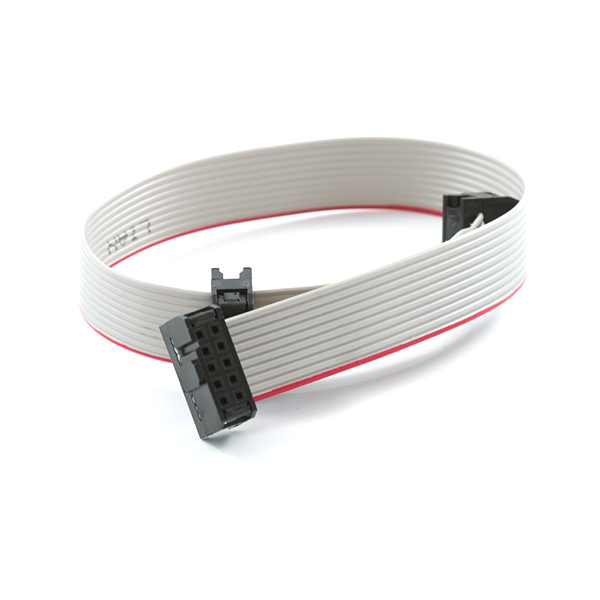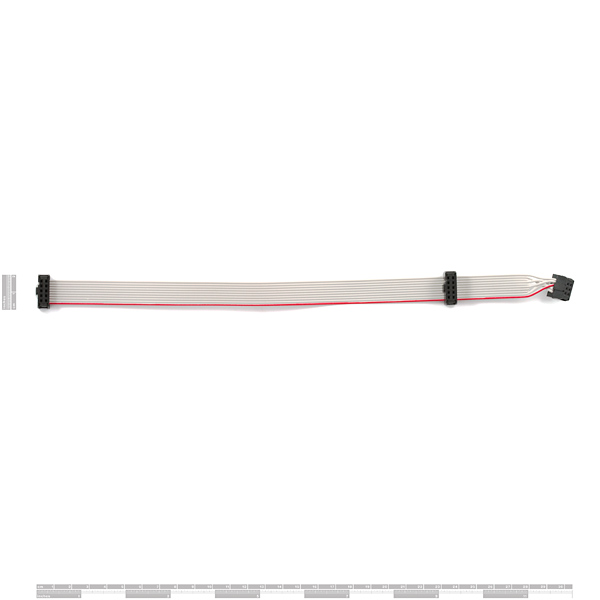AVR Programming Cable Product Help and Resources
Installing an Arduino Bootloader
December 4, 2013
This tutorial will teach you what a bootloader is and why you would need to install or reinstall it. We will also go over the process of burning a bootloader by flashing a hex file to an Arduino microcontroller.
Comments
Looking for answers to technical questions?
We welcome your comments and suggestions below. However, if you are looking for solutions to technical questions please see our Technical Assistance page.
Customer Reviews
4.3 out of 5
Based on 3 ratings:
4 of 4 found this helpful:
Failure prone
This is, fundamentally, a 10 pin IDC cable, with an extra 6 pin socket at the end. Between the 10 pin plug near one end and the 6 pin plug at the end, the IDC cable is taken apart and the individual wires inserted into the 6 pin socket with the correct orientation.
It's a very clever way to solve the problem at hand, but the issue is that separating the individual wires of ribbon cable dramatically weakens them. The reason I show up as a "verified purchaser" is that I had to replace the one that came with my Pocket AVR programmer.
After the second failure, I've taken to crimping individual 26 gauge wires and inserting them into DIP headers (5x2 on one end, 3x2 on the other) instead.
0 of 1 found this helpful:
It is easy to use
Works for me
I've seen some complaints here and there of issues with this cable, and where I can't speak for them I will say that I have had no issue with mine personally.



I am at Starbucks and don't have a multimeter with me. Which way does the 6-pin connector go on an UNO?
Nevermind-I found it: whichever way the green power LED comes on. Hah!
For anyone else wondering, I took some photos of the connector: isp connector on uno
I wish I read blink4jona's comment before buying as what I received is not what I expected. The cable can connect ISP 10-pin to 10-pin, 10-pin to 6-pin, but not 6-pin to 6-pin (there is only a single 6-pin connector).
The description is misleading as it suggests both 10-pin and 6-pin ISP interfaces are supported. Also you can not tell from the picture that only a single 6-pin connector is included.
Although it may be useful to some, we need a no fuzz 6-pin to 6-pin alternative.
for what it's worth, I just bought some 2x3 female headers and the crimp pins you jam into them from digikey and made 6 pin, 2x3, female-female programing cable with my usual 22 gauge hookup cable.
Still can't figure out what everyone else with an AVR dragon is doing to program with the ISP.
okay, after trying to make my own cables I switched gears and bought some premade ones from the microcontrolershop. I use ann AVR dragon and they sell 6-pin 6-pin that work for all arduino and many avr dev boards.
One of these cables came with my AVR Pocket Programmer, but was defective. After a month of trying to figure out why I kept getting the "initialization failed, rc=-1" error, I jammed a few 2-row male headers into the cable and went to town with a continuity tester. Sure enough, the MOSI on the 6-pin plug was open. I stuck a few male-male jumpers between the 10-pin plug and my target AVR and bingo-presto, it worked perfectly.
So, for anyone who gets the rc=-1 error, and has "Power" "D-" and "Stat1" lit up, try replacing the cable first! I hope this helps someone out there. Now I'm off to find some ribbon cable-making doohickeys...
This cable works well with the AVR Dragon and Olimex proto boards -- it can do both JTAG and ISP mode.
Could we get the schematic for this cable posted?
I found a nice one at tinkerlog.
Just remember to mirror it, since you're dealing with the cable, not the header.
is there a reason SF doesn't sell a 6 pin to 6 pin cable? I want to connect an AVR dragon to various micros, all of which have the 2x3 header, and I can't find a 6-6 pin cable. I am new to this so maybe I am missing something obvious. I know the JTAG connection requires 10 (2x5) pins, but most of 8 bit AVRs can't be programmed by JTAG, right?
Right now I am using this together with the AVR programming adaptor, just seems like kind of a kludge.